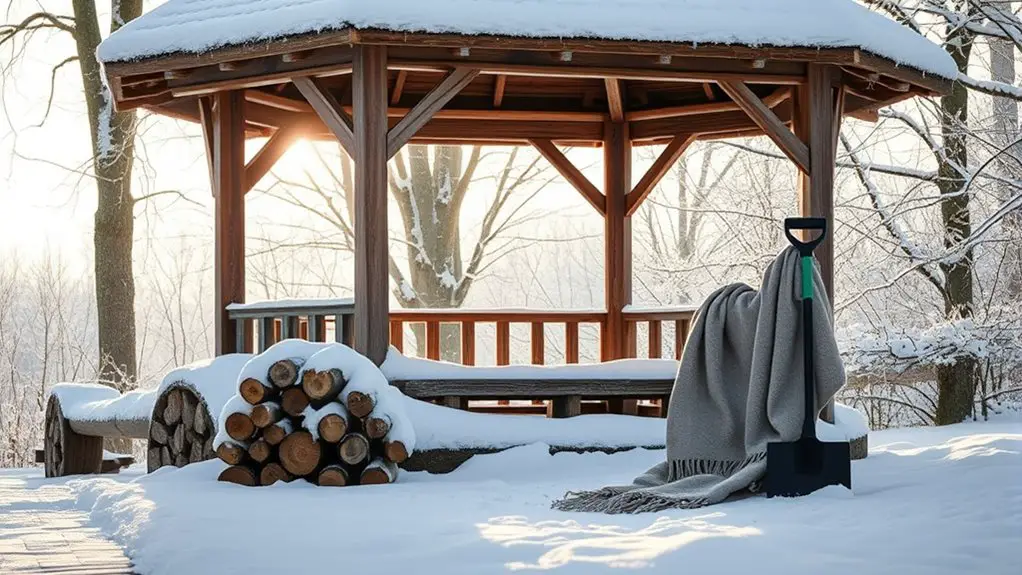To prepare your gazebo for winter, start by inspecting its structure for any damage and reinforce compromised areas. Clean and store your furniture properly, removing cushions and using breathable covers. Clear snow regularly and consider installing a snow guard system to manage snow load. Check the roof for cracks and blockages, and apply sealants to prevent leaks. Finally, add weatherproofing measures like insulation and seals around openings. Continue on to discover more detailed steps for effective winter preparation.
Inspect and Repair the Structure
Before winter sets in, it’s crucial to inspect and repair the structure of your gazebo to guarantee it withstands the harsh elements. Start by examining the overall structural integrity; check for any signs of rot, cracks, or loose connections. Pay special attention to load-bearing components, as these are critical for stability.
Next, focus on wood preservation. Treat exposed wood surfaces with a high-quality sealant or wood preservative to fend off moisture damage and pests. Confirm all fasteners are secure, replacing any rusted or damaged screws and bolts.
If you find significant damage, consider reinforcing joints or replacing compromised boards to maintain strength and durability. Additionally, perform regular inspections for signs of rust to address any emerging issues before they escalate. By taking these proactive measures, you’ll safeguard your gazebo, allowing it to remain a cherished retreat even in the depths of winter. This attention to detail not only enhances its longevity but also guarantees your freedom to enjoy it year-round.
Clean and Store Furniture
As winter approaches, it’s crucial to clean and store your gazebo furniture properly to prevent damage from harsh weather conditions. Start by removing any cushions and fabric components; these should be washed according to the manufacturer’s instructions. Once clean, allow them to dry completely to avoid mildew. For metal or wood furniture, wipe down surfaces with a mild soap solution to remove dirt and grime. Rinse and dry thoroughly to prevent rust or rot.
Next, consider using furniture covers to shield your items from moisture and debris. Opt for breathable materials to avoid trapping humidity underneath. If space allows, utilize storage solutions like a dedicated shed or storage bins to keep your furniture safe and organized throughout winter. For larger pieces, stacking smaller items on top can maximize space. Additionally, it’s important to regularly clean your gazebo furniture to ensure its longevity and appearance. By taking these steps, you’ll guarantee your gazebo furniture remains in top condition for the warmer months ahead.
Protect Against Snow and Ice
Once your furniture is safely stored away, it’s time to focus on protecting your gazebo from snow and ice accumulation. Start by evaluating the structural integrity of your gazebo to guarantee it can handle the potential snow load. Snow can quickly pile up, adding excessive weight that may compromise the stability of your structure.
To mitigate this risk, consider installing a snow guard system, which helps to redistribute snow load evenly across the roof. Additionally, regularly clear off any accumulated snow to prevent ice formation and further weight stress.
For ice accumulation, you might want to apply a de-icing agent to pathways around the gazebo, ensuring safe access during winter months. Finally, inspect any drainage systems to verify they’re functioning correctly, as clogged gutters can lead to ice dams, causing water to seep into the gazebo’s structure. Taking these steps will help maintain your gazebo’s integrity throughout winter. Additionally, ensure your gazebo has a galvanised steel roof that can withstand heavy snow loads, providing extra peace of mind during winter storms.
Check and Maintain the Roof
The roof of your gazebo plays an essential role in its overall durability, especially during winter months. Start with a thorough roof inspection to identify any signs of damage, such as cracks, loose shingles, or leaks. Make certain to check the seams and edges where water could seep in. If you spot any issues, address them immediately to prevent further deterioration.
Next, consider roof sealing to enhance your gazebo’s protection against harsh winter weather. Applying a quality sealant can help waterproof the roof and extend its lifespan. Verify the surface is clean and dry before applying the sealant for maximum adhesion. Additionally, remember that regular maintenance is crucial for longevity, as it helps prevent issues before they escalate.
Finally, clear away any debris, like leaves or branches, that can accumulate on the roof. This will prevent mold growth and reduce the risk of water pooling. By keeping your roof in top shape, you’ll maintain your gazebo’s integrity throughout the winter months.
Add Weatherproofing Measures
While preparing your gazebo for winter, adding weatherproofing measures is essential to protect it from freezing temperatures and moisture. Start by applying weather resistant sealants to all joints and seams, guaranteeing no water seeps in. Consider using insulation materials in areas prone to drafts, like under the roof and around windows, to maintain a stable temperature inside. Additionally, ensure you apply waterproofing agents to the gazebo’s structure to enhance protection against moisture.
Here are some effective weatherproofing steps:
- Inspect and replace any damaged caulking or seals.
- Use heavy-duty tarps to cover any exposed furniture or fixtures.
- Install weather stripping around doors and windows for additional insulation.
- Confirm proper drainage around the gazebo to prevent water accumulation.
Frequently Asked Questions
Can I Leave My Gazebo Open During Winter Months?
You can leave your gazebo open during winter months, but proper winter maintenance is essential. Ensuring its durability means checking for snow load and potential ice damage to avoid costly repairs later on.
Should I Cover My Gazebo With a Tarp?
Covering your gazebo with a tarp shields it from harsh winter elements, ensuring longevity. Tarp benefits include protection against moisture and debris, which simplifies your gazebo maintenance, granting you peace of mind while enjoying your outdoor space.
How Often Should I Check My Gazebo in Winter?
You should conduct winter inspections of your gazebo at least once a month. Regular gazebo maintenance helps identify issues early, preventing damage from snow accumulation or frost. Stay proactive for ideal functionality and longevity throughout the winter months.
Is It Safe to Use a Heater in the Gazebo?
Using a heater in your gazebo can be tempting, but you must prioritize safety. Consider gazebo heating safety protocols and explore winter heating options that minimize risks like carbon monoxide buildup or fire hazards. Always stay vigilant.
What Materials Are Best for Gazebo Winter Coverings?
For winter coverings, consider durable materials like heavy-duty tarps, vinyl, or weather-resistant fabric. These gazebo materials provide insulation and protection against snow and ice, ensuring your structure remains intact and ready for use come spring.

